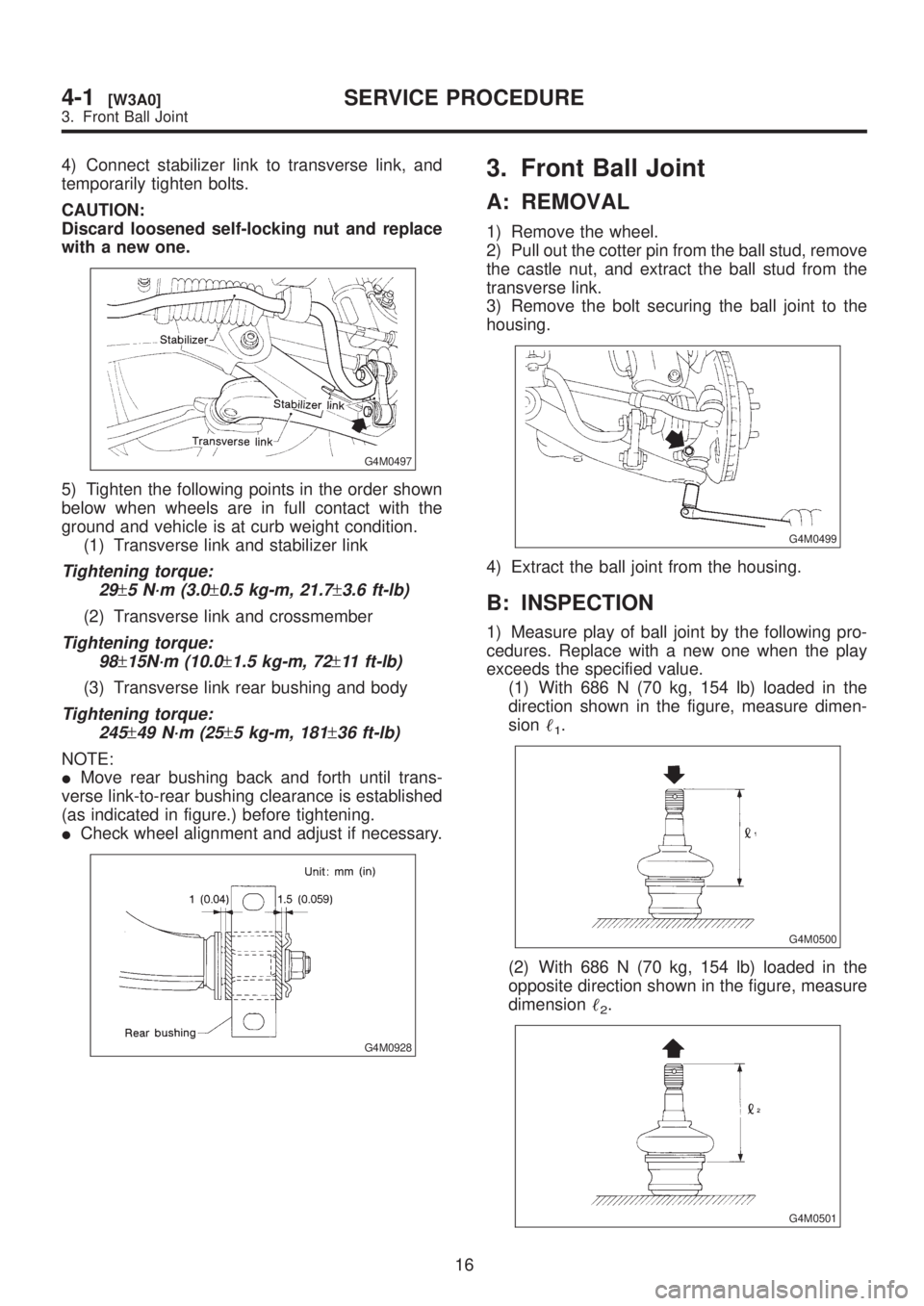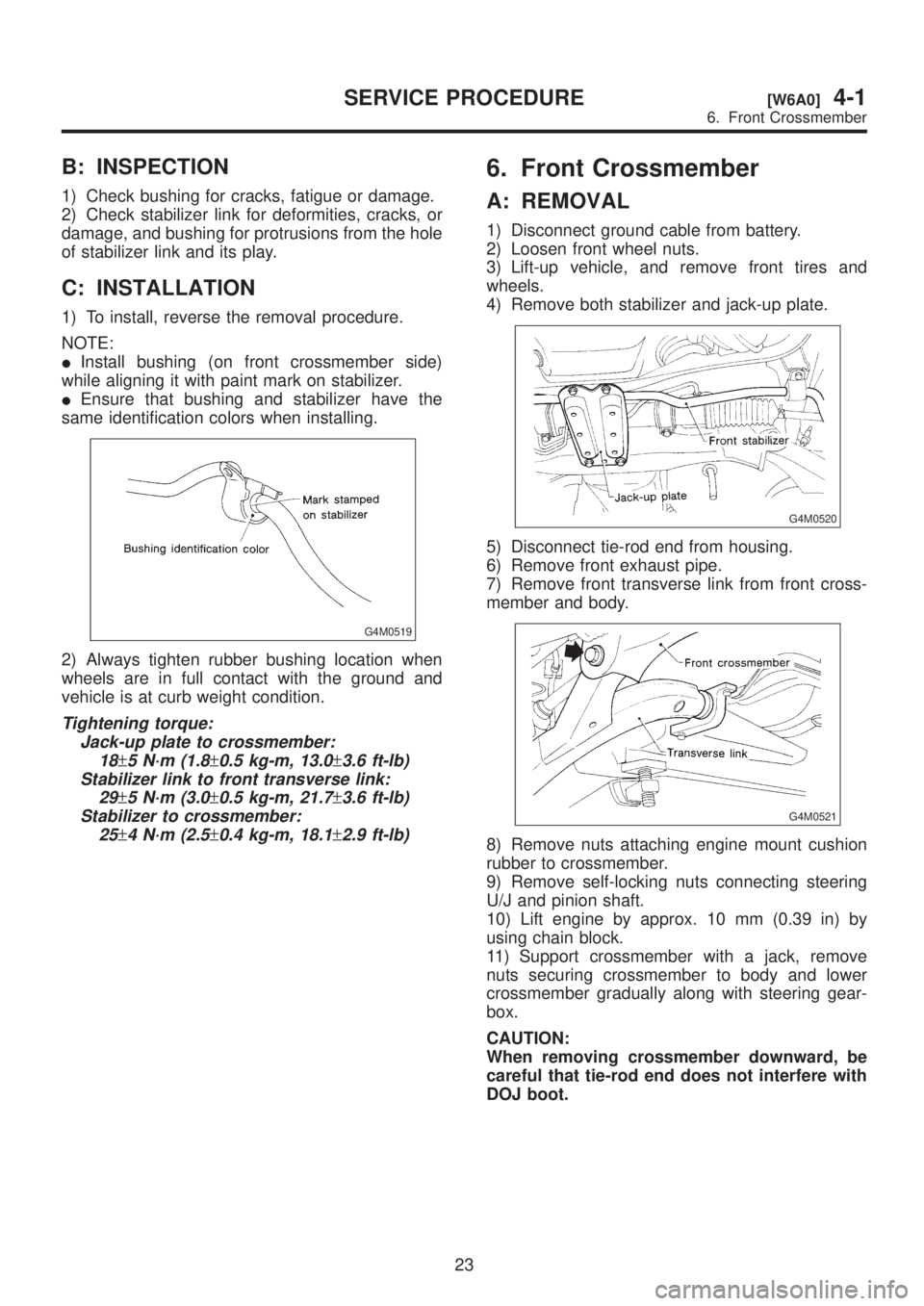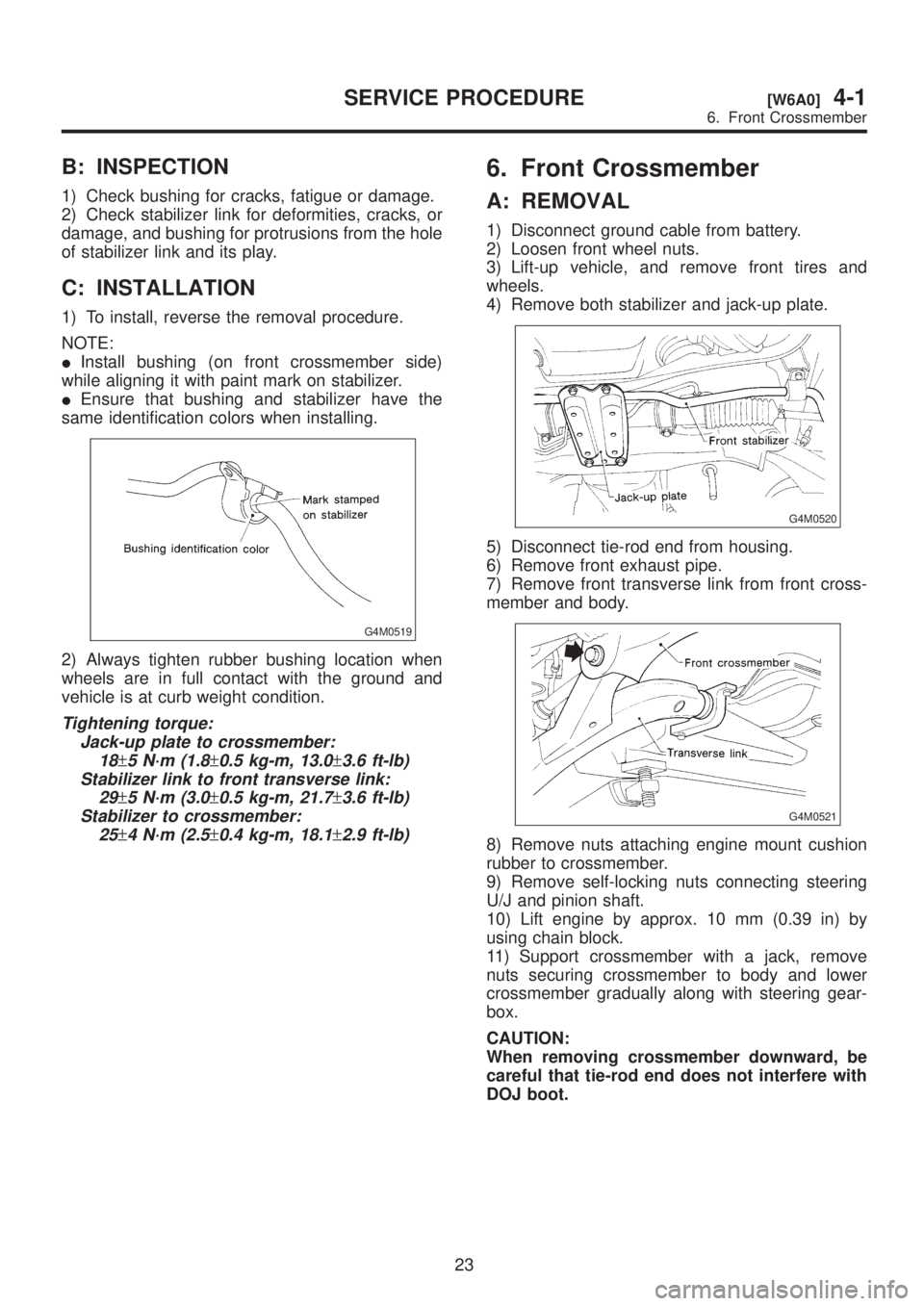Page 719 of 1456

4) Connect stabilizer link to transverse link, and
temporarily tighten bolts.
CAUTION:
Discard loosened self-locking nut and replace
with a new one.
G4M0497
5) Tighten the following points in the order shown
below when wheels are in full contact with the
ground and vehicle is at curb weight condition.
(1) Transverse link and stabilizer link
Tightening torque:
29
±5 N´m (3.0±0.5 kg-m, 21.7±3.6 ft-lb)
(2) Transverse link and crossmember
Tightening torque:
98
±15N´m (10.0±1.5 kg-m, 72±11 ft-lb)
(3) Transverse link rear bushing and body
Tightening torque:
245
±49 N´m (25±5 kg-m, 181±36 ft-lb)
NOTE:
IMove rear bushing back and forth until trans-
verse link-to-rear bushing clearance is established
(as indicated in figure.) before tightening.
ICheck wheel alignment and adjust if necessary.
G4M0928
3. Front Ball Joint
A: REMOVAL
1) Remove the wheel.
2) Pull out the cotter pin from the ball stud, remove
the castle nut, and extract the ball stud from the
transverse link.
3) Remove the bolt securing the ball joint to the
housing.
G4M0499
4) Extract the ball joint from the housing.
B: INSPECTION
1) Measure play of ball joint by the following pro-
cedures. Replace with a new one when the play
exceeds the specified value.
(1) With 686 N (70 kg, 154 lb) loaded in the
direction shown in the figure, measure dimen-
sion
1.
G4M0500
(2) With 686 N (70 kg, 154 lb) loaded in the
opposite direction shown in the figure, measure
dimension
2.
G4M0501
16
4-1[W3A0]SERVICE PROCEDURE
3. Front Ball Joint
Page 720 of 1456
(3) Calculate plays from the following formula.
S=
2þ1(4) When plays are larger than the following
value, replace with a new one.
FRONT BALL JOINT
Specified play for replacement:
Less than 0.3 mm (0.012 in)
2) When play is smaller than the specified value,
visually inspect the dust cover.
3) If the dust cover is damaged, replace with the
new ball joint.
4) Check ball joint for damage and cracks. If
defective, replace with new one.
C: INSTALLATION
1) Install ball joint onto housing.
Torque (Bolt):
49
±10 N´m (5.0±1.0 kg-m, 36±7 ft-lb)
CAUTION:
Do not apply grease to tapered portion of ball
stud.
2) Connect ball joint to transverse link.
Torque (Castle nut):
39 N´m (4.0 kg-m, 29 ft-lb)
3) Retighten castle nut further within 60É until a
slot in castle nut is aligned with the hole of ball stud
end, then insert new cotter pin and bend it around
castle nut.
4) Install front wheel.
17
[W3C0]4-1SERVICE PROCEDURE
3. Front Ball Joint
Page 721 of 1456
4. Front Strut
A: REMOVAL
B4M1085A
(1) Dust seal
(2) Strut mount
(3) Spacer
(4) Upper spring seat
(5) Rubber seat
(6) Dust cover(7) Helper
(8) Coil spring
(9) Damper strut
(10) Adjusting bolt
(11) Self-locking nutTightening torque: N´m (kg-m, ft-lb)
T1:
20±6 (2.0±0.6, 14.5±4.3)
T2:54±5 (5.5±0.5, 39.8±3.6)
T3:152±20 (15.5±2.0, 112±14)
1) Remove wheel.
2) Depress brake pedal and hold it down using a
wooden block etc.
3) Remove union bolts from caliper.
CAUTION:
Use brake hose cap to prevent brake fluid from
escaping.
G4M0503
4) Remove brake hose clamp and disconnect
brake hose from strut. Attach brake hose to body
using gum tape.
G4M0504
5) Scribe an alignment mark on the camber
adjusting bolt which secures strut to housing.
6) Remove bolt securing the ABS sensor harness.
(ABS equipped models.)
18
4-1[W4A0]SERVICE PROCEDURE
4. Front Strut
Page 724 of 1456

9) Using hexagon wrench to prevent strut rod from
turning, tighten self-locking nut with ST.
ST 927760000 STRUT MOUNT SOCKET
Tightening torque:
54
±5 N´m (5.5±0.5 kg-m, 39.8±3.6 ft-lb)
G4M0507
10) Loosen the coil spring carefully.
E: INSTALLATION
1) Install strut mount at upper side of strut to body
and tighten with nuts.
Tightening torque:
20
±6 N´m (2.0±0.6 kg-m, 14.5±4.3 ft-lb)
2) Connect housing to lower side of strut.
3) Position aligning mark on camber adjusting bolt
with aligning mark on lower side bracket of strut.
CAUTION:
IWhile holding head of adjusting bolt, tighten
self-locking nut.
IBe sure to use new self-locking nut.
Tightening torque:
152
±20 N´m (15.5±2.0 kg-m, 112±14 ft-lb)
4) Install ABS sensor harness to strut. (ABS
equipped models.)
Tightening torque:
152
±20N´m (15.5±2.0 kg-m, 112±14 ft-lb)
5) Install brake hose at lower side of strut with
clamp.
6) Install union bolts which secure brake caliper to
brake hose.
Tightening torque:
18
±3 N´m (1.8±0.3 kg-m, 13.0±2.2 ft-lb)
G4M0503
CAUTION:
Be sure to bleed air from brake system.
7) Install wheels.
NOTE:
Check wheel alignment and adjust if necessary.
21
[W4E0]4-1SERVICE PROCEDURE
4. Front Strut
Page 726 of 1456

B: INSPECTION
1) Check bushing for cracks, fatigue or damage.
2) Check stabilizer link for deformities, cracks, or
damage, and bushing for protrusions from the hole
of stabilizer link and its play.
C: INSTALLATION
1) To install, reverse the removal procedure.
NOTE:
IInstall bushing (on front crossmember side)
while aligning it with paint mark on stabilizer.
IEnsure that bushing and stabilizer have the
same identification colors when installing.
G4M0519
2) Always tighten rubber bushing location when
wheels are in full contact with the ground and
vehicle is at curb weight condition.
Tightening torque:
Jack-up plate to crossmember:
18
±5 N´m (1.8±0.5 kg-m, 13.0±3.6 ft-lb)
Stabilizer link to front transverse link:
29
±5 N´m (3.0±0.5 kg-m, 21.7±3.6 ft-lb)
Stabilizer to crossmember:
25
±4 N´m (2.5±0.4 kg-m, 18.1±2.9 ft-lb)
6. Front Crossmember
A: REMOVAL
1) Disconnect ground cable from battery.
2) Loosen front wheel nuts.
3) Lift-up vehicle, and remove front tires and
wheels.
4) Remove both stabilizer and jack-up plate.
G4M0520
5) Disconnect tie-rod end from housing.
6) Remove front exhaust pipe.
7) Remove front transverse link from front cross-
member and body.
G4M0521
8) Remove nuts attaching engine mount cushion
rubber to crossmember.
9) Remove self-locking nuts connecting steering
U/J and pinion shaft.
10) Lift engine by approx. 10 mm (0.39 in) by
using chain block.
11) Support crossmember with a jack, remove
nuts securing crossmember to body and lower
crossmember gradually along with steering gear-
box.
CAUTION:
When removing crossmember downward, be
careful that tie-rod end does not interfere with
DOJ boot.
23
[W6A0]4-1SERVICE PROCEDURE
6. Front Crossmember
Page 727 of 1456

B: INSPECTION
1) Check bushing for cracks, fatigue or damage.
2) Check stabilizer link for deformities, cracks, or
damage, and bushing for protrusions from the hole
of stabilizer link and its play.
C: INSTALLATION
1) To install, reverse the removal procedure.
NOTE:
IInstall bushing (on front crossmember side)
while aligning it with paint mark on stabilizer.
IEnsure that bushing and stabilizer have the
same identification colors when installing.
G4M0519
2) Always tighten rubber bushing location when
wheels are in full contact with the ground and
vehicle is at curb weight condition.
Tightening torque:
Jack-up plate to crossmember:
18
±5 N´m (1.8±0.5 kg-m, 13.0±3.6 ft-lb)
Stabilizer link to front transverse link:
29
±5 N´m (3.0±0.5 kg-m, 21.7±3.6 ft-lb)
Stabilizer to crossmember:
25
±4 N´m (2.5±0.4 kg-m, 18.1±2.9 ft-lb)
6. Front Crossmember
A: REMOVAL
1) Disconnect ground cable from battery.
2) Loosen front wheel nuts.
3) Lift-up vehicle, and remove front tires and
wheels.
4) Remove both stabilizer and jack-up plate.
G4M0520
5) Disconnect tie-rod end from housing.
6) Remove front exhaust pipe.
7) Remove front transverse link from front cross-
member and body.
G4M0521
8) Remove nuts attaching engine mount cushion
rubber to crossmember.
9) Remove self-locking nuts connecting steering
U/J and pinion shaft.
10) Lift engine by approx. 10 mm (0.39 in) by
using chain block.
11) Support crossmember with a jack, remove
nuts securing crossmember to body and lower
crossmember gradually along with steering gear-
box.
CAUTION:
When removing crossmember downward, be
careful that tie-rod end does not interfere with
DOJ boot.
23
[W6A0]4-1SERVICE PROCEDURE
6. Front Crossmember
Page 728 of 1456
B: INSTALLATION
1) Installation is in the reverse order of removal
procedures.
CAUTION:
Always tighten rubber bushing when wheels
are in full contact with the ground and vehicle
is at curb weight condition.
Tightening torque:
Transverse link bushing to crossmember:
98
±15 N´m (10.0±1.5 kg-m, 72±11 ft-lb)
Stabilizer to bushing:
25
±4 N´m (2.5±0.4 kg-m, 18.1±2.9 ft-lb)
Tie-rod end to housing:
27.0
±2.5 N´m (2.75±0.25 kg-m, 19.9±1.8
ft-lb)
Front cushion rubber to crossmember:
69
±15 N´m (7.0±1.5 kg-m, 51±11 ft-lb)
Universal joint to pinion shaft:
24
±3 N´m (2.4±0.3 kg-m, 17.4±2.2 ft-lb)
Crossmember to body:
98
±15 N´m (10.0±1.5 kg-m, 72±11 ft-lb)
2) Purge air from power steering system.
NOTE:
Check wheel alignment and adjust if necessary.
24
4-1[W6B0]SERVICE PROCEDURE
6. Front Crossmember
Page 729 of 1456
7. Rear Trailing Link
A: REMOVAL
H4M1066C
(1) Trailing link
(2) Front bushing
(3) Rear bushing
(4) Bracket(5) Housing
(6) Self-locking nutTightening torque: N´m (kg-m, ft-lb)
T1:
98±20 (10.0±2.0, 72±14)
T2:11 3±15 (11.5±1.5, 83±11 )
1) Loosen rear wheel nuts.
2) Lift-up vehicle, support it with safety stands
(rigid racks) and remove rear wheels.
3) Remove both rear parking brake clamp and
ABS sensor harness. (ABS equipped models.)
4) Remove bolt which secure trailing link to trailing
link bracket.
B4M0570A
5) Remove bolt which secure trailing link to rear
housing.
25
[W7A0]4-1SERVICE PROCEDURE
7. Rear Trailing Link